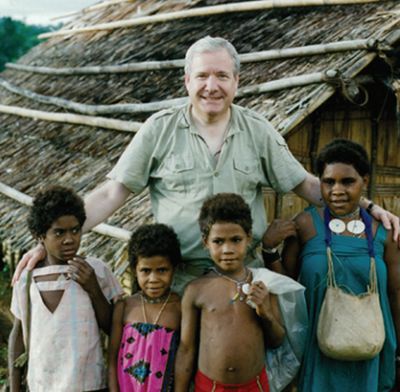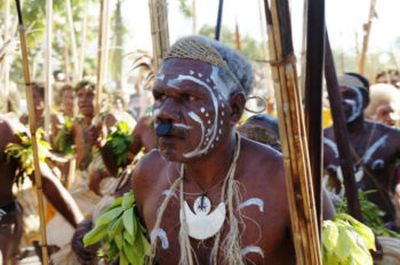
Originally published in God Reports
The interior of Malaita in the Solomon Island chain had a long history of opposition to missionaries and other outsiders — sometimes violent resistance by the Kwaio tribal group.
In 1927, 13 government officials from the UK were massacred by the Kwaio as they attempted to survey the area for taxation purposes. The British government responded by sending a warship to shell that part of the island, which resulted in the deaths of 200 Kwaio.
Later, several Roman Catholic priests were killed by the group. In 1965 a Protestant missionary from New Zealand was martyred as he attempted to evangelise the Kwaio. Ten years later, a medical missionary and his son were also killed.
Look what God is doing
But God had a plan to reach the Kwaio using missionaries from Fiji in 1990, as told in the compelling book, Look What God is Doing, by Dick Eastman, president of Every Home for Christ (EHC).
It seems several Fijian evangelists affiliated with EHC who had been part of a campaign to reach Fiji’s 106 islands turned their attention to the 100 islands of the Solomon chain, 1 000 miles away.
They reached the island of Malaita and spent time evangelising the coastal areas. One night as their team sat around a campfire, a team member pointed to the rugged interior of the island and asked, “Are there people there who have yet to hear about Jesus?”
“Yes,” one replied. “It’s one of the most difficult areas in all of the islands to evangelise because of the rugged terrain and the hostile people.”
An argument ensued within the team as they heard more about the history of the people group. Some were intimidated and urged caution. Cannibalism had been practiced until the end of the last century; who could be sure it had not ceased?

Praying and fasting
The team finally agreed they would pray and fast for seven days before attempting to send a team to reach the Kwaios.
With the help of two witch doctors who had become believers, a list of 87 different evil spirits were identified that were said to hold sway in the region. They pointedly confronted each demonic entity with focused warfare prayer over the seven-day period, according to Eastman’s book.
On the eighth day, Jack and Japta joined 10 other Christian workers on a day-long journey into the rugged interior of the island.
About five o’clock in the afternoon Jack and Japta reached one village where there was a large assembly of people, indicating something unusual might be going on. The two men were quickly surrounded by several large warriors, wanting to know where they were from and why they had come.
Bringing the Good News
“Jack explained as quickly as he could in the Kwaio language that they were bringing the Kwaio people Good News,” Eastman noted. “But the burly guardians led them away to be questioned by five village priests or elders. These were elders who had gathered in anticipation of the impending death of their chief.
“The strangers had arrived at a sacred moment and might be infringing on the customs of the Kwaio — a taboo of taboos that could meet with dire consequences.”
As the Christians were questioned, they could not help but notice some of the large warriors standing near them had 24-inch machetes and some carried bows with poison-tipped arrows.
“Why are you here?” one of the elders demanded.
“We have come to share Good News,” they repeated once more, as they went on to describe the one true God who created everything in the heavens and on earth — including the Kwaio. “Our eternal God sent His only Son to be like us, a man, and to sacrifice His own life willingly on our behalf.”
The elders said they had never heard a message like this. They understood the concept of a blood sacrifice, however. After a few moments of heated discussion one said, “We cannot believe anything you say unless our chief believes.”
Jack and Japta requested permission to see the chief, knowing it was customary in many villages to seek approval from the chief. Once granted, that would open up opportunities for their message to be heard.
The chief was dying
The elders refused because their chief, Haribo, was dying. Seeing him was out of the question.
Then one of the Christians had an idea. “When Jesus Christ came as the Son of God, He came not only to deliver men from their sins, but to heal sick people, too. God is quite capable of healing your chief.” In response, the elders began to argue among themselves.
Jack and Japta spent the night locked in a hut, but at seven the next morning the elders returned with surprising news. They were granted permission to pray for Chief Haribo!
When they entered the chief’s hut, they could see he was very old and weak, struggling for breath, near death.
“Jack shared with him quickly God’s plan of salvation, explaining that Jesus was the only way to eternal life,” Eastman recounted.

An amazing response
The chief had a most amazing response. “I have waited my entire lifetime to hear this story,” he told them. “I have always felt there was some sacred message like this. But no one ever came to bring us such words. How can I receive this Jesus into my life?”
Jack and Japta led Chief Haribo in the sinner’s prayer. A few moments later a profound peace transformed the countenance of the chief.
But two hours later the chief died. For the rest of the day, his body was prepared for a traditional Kwaio burial. Meanwhile, Jack and Japta left the village and headed back to the coast.
But as dusk descended on the village something shocking happened. Chief Haribo sat up and began to speak!
“Let the elders gather,” he said to his startled hearers, “and let someone go and find the boys who came earlier to tell me about Jesus.”
Seeing heaven
When they gathered, the chief related an amazing story about seeing heaven. “A being dressed in glorious white had taken him a great distance to the most beautiful place he had ever seen,” Eastman recounted.
“A person called Jesus Christ, the Son of God the young men had told him about, was being worshiped by a huge crowd of people. The glorious being explained to him that this beautiful place was where people who believed in Jesus would go for all eternity to worship Him. So everything the boys said was true.”
“Peace had come to his life, Haribo said, and he had no more pain, nor had he seen any suffering among the people who worshiped Jesus.”
Chief Haribo also gave the names of several Old Testament prophets he met in heaven.
“Then the being in white showed him another place — a place of great torment where people go who reject the message of Jesus.”
The being in white told the chief he had to go back for a short time to tell the elders of the village that the message about Jesus was true. “This Jesus is the only way to experience eternal life,” he said.
Brought back to preach to the village
When the chief learned that Jack and Japta had left, he ordered runners to go after them and bring them back so they could preach to the rest of the village.
When Jack and Japta returned they were astounded by what had happened. They presented the message of salvation again, this time to the entire village.
“Every person, including Chief Haribo’s immediate family of 21 members, received Christ as their Saviour. And soon more than 300 villagers throughout the area (in 10 nearby villages) had surrendered their lives to Christ.”
“Haribo remained alive all that night and into the next morning. Then he lay back down quietly in his earth bed and went to be forever with Jesus.”
By 2012, more than 8 000 Kwaios became followers of Jesus, including 1 000 in the most remote areas.







Glory be to God!!!
There is nothing too hard for our God. Praise His name.
wow……